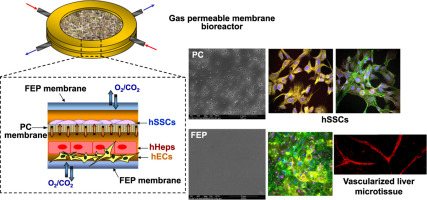当前位置:
X-MOL 学术
›
J. Membr. Sci.
›
论文详情
Our official English website, www.x-mol.net, welcomes your feedback! (Note: you will need to create a separate account there.)
GAS PERMEABLE MEMBRANE BIOREACTOR FOR THE CO-CULTURE OF HUMAN SKIN DERIVED MESENCHYMAL STEM CELLS WITH HEPATOCYTES AND ENDOTHELIAL CELLS
Journal of Membrane Science ( IF 9.5 ) Pub Date : 2018-10-01 , DOI: 10.1016/j.memsci.2018.06.029 Simona Salerno , Efrem Curcio , Augustinus Bader , Lidietta Giorno , Enrico Drioli , Loredana De Bartolo
Journal of Membrane Science ( IF 9.5 ) Pub Date : 2018-10-01 , DOI: 10.1016/j.memsci.2018.06.029 Simona Salerno , Efrem Curcio , Augustinus Bader , Lidietta Giorno , Enrico Drioli , Loredana De Bartolo

|
Abstract In this study a human liver tissue construct was created by using human skin derived mesenchymal stem cells (hSSCs), primary human hepatocytes (hHeps) and human endothelial cells (hECs) co-cultured in a gas permeable membrane bioreactor developed in two different configurations in order to create direct and interconnected co-cultures. A single chamber configuration consisting of two flat-sheet gas permeable fluorinated ethylene propylene (FEP) membranes was used for the direct co-culture of cells in contact each other and with membrane. To establish interconnected co-culture we developed a compartmentalized bioreactor in which hHeps and hECs adhered to FEP membrane are separated from hSSCs through a microporous polycarbonate (PC) membrane that allows the communication between cells by means of their secreted paracrine factors. In both gas permeable membrane bioreactors, biliary ducts and vascular capillaries were tightly distributed, mimicking the natural hepatic lobules. Cells displayed relevant albumin and urea synthesis as well as drug metabolism in both direct and interconnected cultures. In the compartmentalized bioreactor, the liver specific functions were prominent thanks to the biochemical communications between the different compartments as confirmed by the experimental and computational analysis. The investigation on the expression of specific mesenchymal, hepatic and endothelial markers suggested the ability of hSSCs to start the differentiation in hepatocyte phenotype expressing specific hepatocyte markers (e.g., albumin, α fetoprotein, HSA and CK19). A dual purpose accomplished the bioreactor: the creation of a vascularized liver microtissue thanks to the positive influence of biochemical signalling and stimuli from hSSCs; the production of partially differentiated hSSCs-derived cells that could be harvested as a cell source for liver tissue engineering.
更新日期:2018-10-01


























 京公网安备 11010802027423号
京公网安备 11010802027423号